Create
Vintage St. Pete: The Soreno Hotel
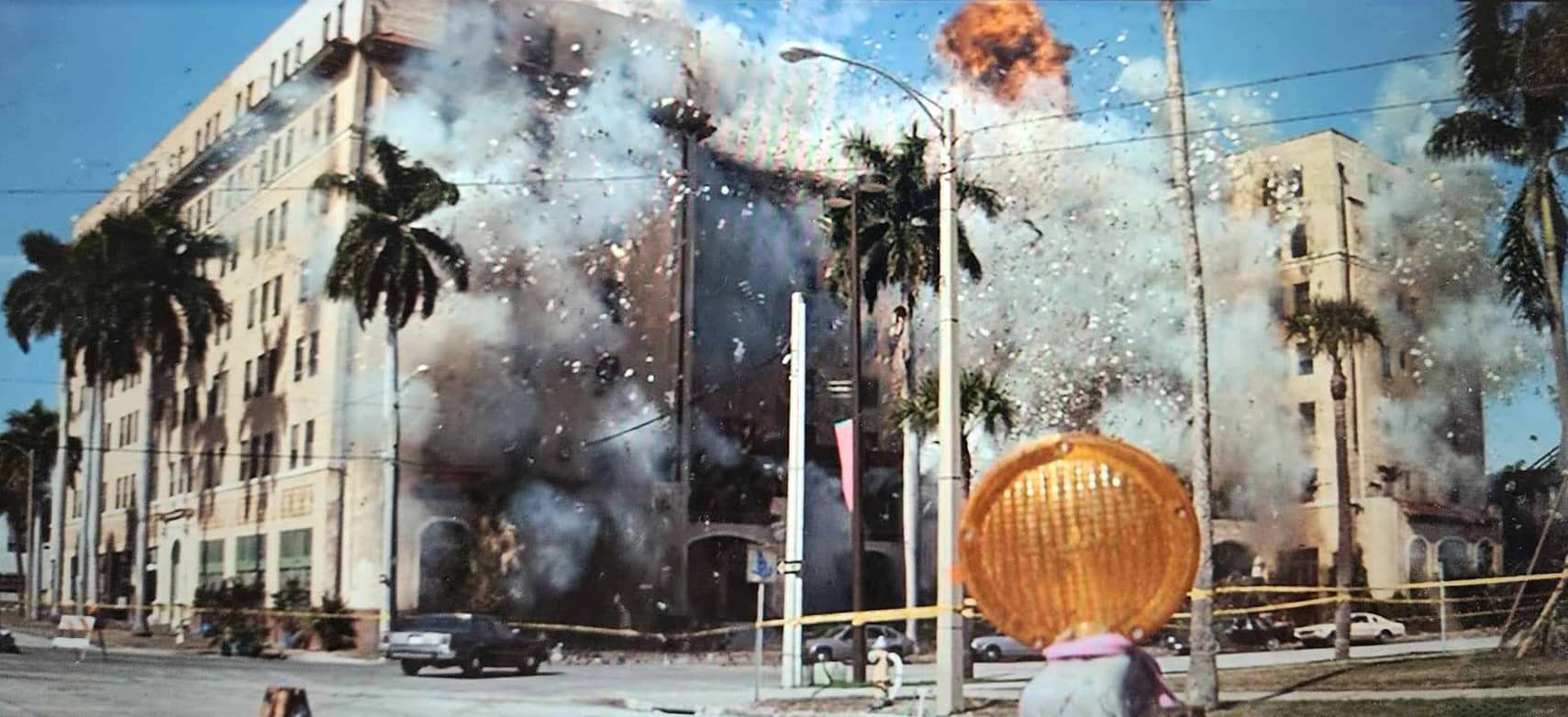
St. Petersburg’s road from winter playground to retirement village to buzzing metropolis has been long and bumpy. Arguments over what should remain, and what should be taken down and built over in the name of progress, have raged for a century.
The Soreno Hotel, which loomed seven stories above the bayfront for almost 70 years, at the intersection of Beach Drive and 1st Avenue North, could’ve been the poster child for the tug of war between developers and preservationists.
Built in 1923, the Soreno was the city’s first million-dollar hostelry, although it wasn’t quite as grand as the neighboring Vinoy Park, which opened a year later. “The Vinoy and the Soreno, I viewed as the bookends for the downtown waterfront area,” said Peter Belmont, founder of the activist organization Preserve the ‘Burg. “And so it was important to maintain both of those bookends. We always thought that would provide the impetus to re-use the best of the past.”
The City Council of 1987, however, did not feel the same way, approving a proposition from the Bay Plaza Development Group to build a $200 million shopping and entertainment plaza on nine downtown blocks (the City agreed to put $40 million towards the project). The company promised to attract “high-end” retailers and restaurants.
Which meant the Soreno, as the largest (and by far the oldest) building in the district purchased and/or leased by Bay Plaza, had to go.
Four years of highly-charged rhetoric and recriminations later, the Soreno was imploded in a public spectacle. Bay Plaza had arranged with Warner Bros. pictures to film the controlled demolition – which lasted all of 11 seconds – for insertion into the movie Lethal Weapon 3.
Two weeks prior, a group of approximately 300 people – including Peter Belmont – protested the imminent destruction of the 1920s hotel by holding hands and walking the perimeter, waving signs and chanting.
By that time, they knew it wouldn’t do any good – the decision had been made – but, according to Belmont, now a resident of Oregon, the protestors wanted to make one final statement.
“There really was a lot of public opposition to the Bay Plaza plan,” he said. “The idea was, let’s get people out there and show City Council that it matters.”
The opposition had only increased after the council declined to declare the Soreno an historic landmark, which would save it from the chopping block. Belmont’s group had proposed the plan.
“I think,” said Belmont, “the Soreno came down when it did was because they viewed it as the focal point of the opposition to Bay Plaza. Which it was in many ways. And if they took down the Soreno, maybe the opposition would disappear.”
In the final outcome, Bay Plaza the company got worse reviews than Lethal Weapon 3 the movie. The “high-end” construction never took place.
And still, the Soreno was gone forever.
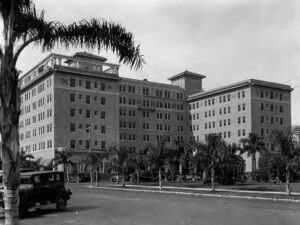
The Soreno, 1926. Photo: Hillsborough County Libraries’ Burgert Brothers Collection.
History lesson
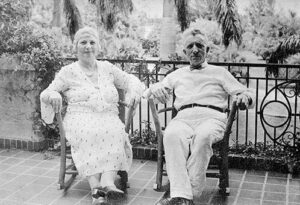
Bertha and Soren Lund. Photo: St. Petersburg Museum of History.
Danish hotelier Soren Lund arrived in St. Petersburg in 1910 to operate the Huntington Hotel, which he did for 10 years. As the 1920s land boom was heating up in Florida, Lund – who’d moved from New York with his wife, Bertha, and their son, Soreno – began planning the first big bayfront resort.
St. Petersburg was a winter town, with wealthy northerners arriving by train or boat to enjoy the balmy weather while cold and snow dominated back at home. Hotel season in St. Pete ran from December through April.
The Soreno, named for the junior Lund, was of Mediterranean Revival design (by architect G. L. Preacher), constructed of concrete block and stucco. When it opened on Jan. 1, 1924, the hotel boasted 250 rooms, each with private bath; this was increased to 300 when a seventh floor was added in 1929.
Aymer Vinoy Laughner, the son of a Pennsylvania oil magnate, opened the larger and more ornate Vinoy Park Hotel on the bayfront in December, 1925.
During the mid 1920s, no fewer than 10 luxury resort hotels were erected in St. Petersburg, including the Princess Martha, the Carleve, the Pheil, the Suwannee, the Dennis, the Rolyat and the Don CeSar.
In 1942, as with the Vinoy Park, the Don CeSar and other hostelries, the Soreno was appropriated by the United States military to serve as troop housing and headquarters; in the Soreno’s case, for the Maritime Services (aka the Merchant Marine) and the army.
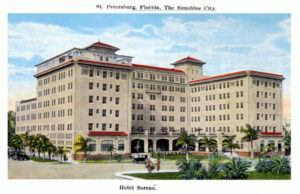
Postcard image.
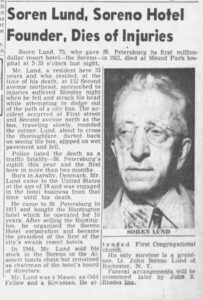 Soreno “Reno” Lund, who’d managed the hotel that bore its name since its first day, went to war as a naval lieutenant. Suffering from post-operative complications, he was recuperating at home in St. Petersburg when he died on March 10, 1944. His mother had passed away the previous year.
Soreno “Reno” Lund, who’d managed the hotel that bore its name since its first day, went to war as a naval lieutenant. Suffering from post-operative complications, he was recuperating at home in St. Petersburg when he died on March 10, 1944. His mother had passed away the previous year.
Perhaps these twin tragedies contributed to Soren Lund’s decision to sell the hotel to Chicago businessman Charles H. Alberding and his Alsonett Hotels organization. The Soreno changed hands in the autumn of 1944, as it was being polished and prepped for its first post-war tourist season.
Lund, who stayed on as President of the Soreno Board of Directors, died in a traffic accident in the summer of ’46.
Under the Alsonett banner, the Soreno continued as a winter resort through the decades.
 Owner Alberding closed the aging hotel in 1984, after the city fire marshal had issued repeated notices of code violations. Manager Martin C. McNiel told the St. Petersburg Times they just couldn’t afford to widen some corridors, as required, and install a sprinkler system.
Owner Alberding closed the aging hotel in 1984, after the city fire marshal had issued repeated notices of code violations. Manager Martin C. McNiel told the St. Petersburg Times they just couldn’t afford to widen some corridors, as required, and install a sprinkler system.
New York investor Frederick Guest was at that moment spending millions to rehab and resuscitate the nearby Vinoy Park (now just the Vinoy), and he hoped to enter into a lease agreement with Alberding to do the same for the Soreno. “My intention,” Guest told a reporter, “is to get the Soreno financed simultaneously with the Vinoy to get the tax benefits.”
The Vinoy had fallen into ruin and was the dank playground of derelicts and junkies, while the Soreno had active retailers in its ground floor spaces. Therefore only the hotel – the upper six floors – stood vacant and lacking.
The Vinoy, however, had been added to the National Register of Historic Places in 1978.
As Guest and his fellow financiers worked to retore the Vinoy to its original opulent glory, the Soreno languished. Brandishing flowers, candy and big development promises, Bay Plaza acquired the Soreno, and several small surrounding buildings, during its downtown buying and leasing frenzy in 1986 and ’87. The city government lapped it up.
After considering refurbishment of the landmark hotel into an apartment complex, “Bay Plaza does not intend to commit economic suicide in the renovation of the Soreno Hotel,” wrote the company’s president in a letter to the St. Petersburg city manager, the mayor and the council in July 1991.
The city wanted them to wait until they were ready to build a replacement structure before demolishing the hotel. Bay Plaza said no, that would affect their financing opportunities.
Still, nothing happened. Winds blew off Tampa Bay through the Soreno’s broken windows.
And the back-and-forth got even more contentious. “They’re just going to go ahead with it and do it,” cried vice mayor Connie Kone, who had joined the pro-preservation movement. “Everything that I’m hearing gives me no hope that anything’s going to happen in the downtown in the foreseeable future. So what do we have? A flattened downtown.”
Then came Jan. 25, 1992. With thousands of residents watching from a safe distance, and Warner Bros. cameras rolling, the Soreno collapsed into a pile of smoking rubble.
Demolition was followed just six months later by the successful reopening of the renovated Vinoy.
In 1995, Bay Plaza left St. Petersburg, unable to secure the necessary financing to fulfill its promise. The company had constructed exactly one downtown parking garage.
New owner JMC Communities erected the 21-story Florencia condo complex on the Soreno site.
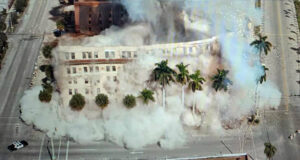
Screenshot, Warner Bros.
The final credits
Lethal Weapon 3 is another by-the-numbers buddy cop movie, with Mel Gibson and Danny Glover reprising their roles as two lawmen – one maverick, one by the book – who form an unlikely alliance. The third film opens with their characters attempting to diffuse a bomb.
When this fails, they escape in the nick of time, as the building – in this case, the old Orlando City Hall – blows up.
The most successful of the four Lethal Weapon action comedies, it would eventually make $320 million at the box office.
The implosion of the Soreno Hotel is shown after the end credits. When most people will have already stopped watching.
In a long shot, a car containing “Gibson” and “Glover” is shown approaching the Soreno, which is cordoned off with yellow police tape. We hear their prerecorded voices as the car moves forward. As “Gibson” (in reality, a stunt double wearing his clothes) exits the passenger door, the building begins to collapse. He jumps back in the car, it screeches backwards and away from the unfolding destruction. Hilarity ensues.
Because it got people excited, Bay Plaza and Warner Bros. had hinted in the media that the two stars would actually be in St. Petersburg to appear in the brief scene, as they had in Orlando the previous October.
That’s not what happened.
Preservationist Belmont has an opinion on this. The film company, he believes, was frustrated with the back-and-forth between the city, Bay Plaza and preservationists.
“Oddly enough, the movie producer, Joel Silver, had an historic preservation streak,” Belmont said. “He reached out to us because he was having problems with Bay Plaza. They were not being very cooperative with scheduling. They (the film company) wanted the demolition to occur when the stars were in town.”
It’s not known whether the actors were ever truly contracted to appear. But the studio’s frustration over the constant rescheduling, according to Belmont, ended up (albeit subtly) in the finished film’s “Special Thanks To” credit sequence: The city’s name is misspelled.

“I think they did that on purpose,” Belmont said.








Daniel J
April 21, 2025at1:18 pm
I was there as a kid when it imploded. Still have vhs tape of it somewhere. Great read.
Pam Thomas
June 23, 2024at9:11 am
Florencia condominium has 5×8 enclosed cases displayed in their common room on the third floor with dishes, glasses, cups, menus, and silverware all belonging to the Soreno Hotel. Great display.